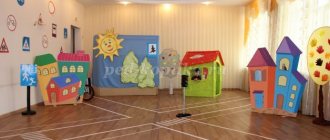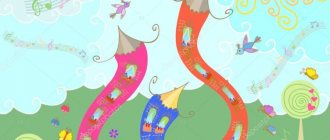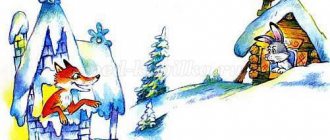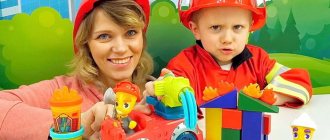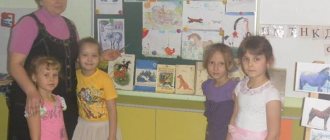Game "Teremok"
We suggest using the game “Teremok” for children aged 9-11 years.
Goals. The game "Teremok" is aimed at clarifying and building interpersonal relationships between children. During the game the following tasks can be solved.
1. Diagnostic. The game is structured in such a way that both adults and students themselves can see the relationships that exist between them.
2. Designing. In a game situation, participants can model the type of relationship that best suits their current needs.
3. Reflective. Participants in the game have the opportunity to comprehend their relationships, norms and rules, and express their own attitude to the situation in the class.
4. Developmental. During the game, children develop their communicative and reflexive skills and their personal development. Real opportunities for forming a team also arise (if the children are ready for this).
PROGRESS OF THE GAME
At its core, “Teremok” is a complex psychodramatic game, since it involves the free development of the plot in accordance with the game actions of the participants. The plot is based on the well-known Russian folk tale “Teremok”. The game can take place in an assembly or sports hall, as well as in a classroom, provided that a certain rearrangement can be made in it. It is necessary to free up a significant space in the center and at the board; chairs according to the number of participants should be placed against the wall in a semicircle (like in a theater). It’s good if you can spread a carpet on the floor: many stages of the game are easier to carry out by sitting the children on the floor.
Leading. Now we will act out the fairy tale “Teremok”. You will become actors gradually. At some point, you will all find yourself “on stage.” While you are in the “auditorium”, behave like educated spectators: carefully follow the action, try not to miss anything. Otherwise, when the time comes to get into character, you may not be ready!
The leader distributes the children into role groups in advance. In total, 4-5 role-playing groups can be involved in the performance: for example, mice, bunnies, hedgehogs, foxes and a group of some exotic animals - kangaroos, ostriches, etc. The number of children in a group depends on how many students there are in the group. This game was created for a small group. At the beginning of the game, children do not know anything about which of them belongs to which group. The presenter begins to read the introductory text of the fairy tale.
Leading. There was a tower in the forest. Nobody lived in it. One day, little mice were running past the mansion. They were looking for a house... etc. The presenter announces which of the children plays the role of mice. The mice are invited to go onto the stage (in the center of the room) and imagine that they have entered a small house. Leading. You can now arrange this house the way you want. The most important thing: you must decide by what rules you will all live together in this house, and indicate on the plan the places of your personal rooms in the mansion.
The presenter shows the children a large square drawn on the board. Inside the square, in one of the corners, some space is enclosed by a line. There are no more lines or drawings there. The presenter invites each mouse to mark the location of his room on the plan (draw a circle) and write his name inside it. Two conditions: the mice must agree with each other on the size and location of their rooms, and they cannot use an enclosed space (this is a guest room). After the room plan is created, the mice are given two sheets of paper. On one it is written: “We accept”, on the other: “We do not.” Children are asked to write three rules on each sheet. While the mice are working, the presenter occupies the audience. These could be riddles, mini-competitions. You can list those children who will play a group of hedgehogs (or any subsequent fairy tale characters) in the play, and discuss with everyone the hedgehogs’ lifestyle. Meanwhile, the mice make up the rules and, at the request of the presenter, voice them out to all viewers. The tale continues. The following “homeless animals” appear on the stage, for example hedgehogs. The presenter invites the hedgehogs to ask to live in the tower. The owners, after hearing the request, must decide whether they will allow new residents, and if so, under what conditions: as equal hosts or as guests. If the owners allow hedgehogs into the house as hosts, the hedgehogs draw their rooms on a general plan. Now they have the right to dispose of the house just like mice. If they are allowed in as guests, then they have no rights, they must live according to the rules of the owners. In this case, the hedgehogs all live together in the guest room. If hedgehogs are not allowed into the house (and the leader must calmly accept any options), they build a small hut nearby. Small, because there are few of them and there is not enough strength to build a serious house. This hut is also depicted on the board as an empty square. It sets aside a room for possible guests, and the children draw their rooms. Residents of the new hut house must also fill out two sheets of rules. If the game takes such a turn, the presenter allocates time to work with the rules. At this time, the residents of the tower can draw their rooms on a piece of paper (“the guests” all draw one room together), and the presenter and the audience discuss the lifestyle of those characters who will next join the game. It is important not to delay this work: once the rules are written, the game continues. New characters appear. The presenter says who will now appear on stage as part of the third group of animals. History repeats itself. By the way, if new characters come to an existing hut, then it increases in size and turns into a mini-house. According to this scenario, the game continues until all the children become participants. By the time all the animals have settled on the stage, the game can take on different shapes. Let's look at the main options.
Option I. Common mansion, and everyone in it is the owner
In this case, the children are invited to return to the discussion of the rules that were created by the first owners of the tower. Since then, many new residents have appeared in the house! All together they must create a new set of laws according to which life in the mansion will go. If, after creating new rules, the children are not tired, you can invite everyone to draw their room on a separate sheet, and then strengthen all the rooms on the board. It turns out to be a multi-apartment “teremok”.
Option II. A common mansion, but there are both guests and owners in it
First of all, the host checks with the guests whether they like their position and whether everything suits them. If so, the guests are invited to sit a little longer in their room, and in the meantime the owners will draw up a general set of rules for life in the mansion and then familiarize the guests with it. This is where the game ends. Experience shows that guests usually do not like their powerless position. They claim to be the owners. It is necessary to give the children the opportunity to discuss the situation: as a result, either everyone becomes the owner of the mansion, or some of the guests leave the mansion and build their own house. Game continues.
Option III. Several towers
Each tower creates its own set of rules and deals with its guests, if they have them. Then the towers must establish the laws of living together in the forest. To do this, they all get together and develop “rules of the forest.” In some cases, conflicts may arise between groups of children. The children declare that they do not want to agree on anything and generally “go to different forests.” The presenter must accept this option, but be persistent in his demand to draw up rules. Leading. There is still only one earth, and it is not very big. You must agree on how you will live on the common land. Random encounters between your residents are possible. How should they be built? You may find yourself on the same river, your ships may meet at sea. How will you handle these and similar situations? It is fundamentally important that children tell each other the rules of the hostel.
Option IV. Teremki and individual residents
It is possible that a split will occur within a group: some will build a common hut, and some participants will want to live independently. They should have this opportunity. In order to settle in the forest on their own, they must write their own set of rules and establish relationships with their neighbors. The game ends when everyone has found a place they like: in a common house, in a guest room, in a mini-house or in a personal hole. The presenter sums up the results and be sure to emphasize the positive side of the game's ending: it is important that everyone understands how it is more convenient for them, understands how others want to live, and is able to find mutual understanding with everyone else and establish the rules of communication. The game does not involve long discussions. You can ask the children whether the game is similar to their real life in the group, how exactly (if it is similar) and how it is different (if it is not similar). It is imperative to find out the mood of each participant after the end of the game. It may be worth talking to someone after the activity, either individually or in a small group. Experience shows that the play action is very captivating for children and they discuss it for a long time with each other and with the teacher/counselor.
TEREMOK as a model
The game presented below can be classified as one of the procedures used in persuasive training. It allows the teenager to independently search for individual, most suitable methods and techniques of persuasive influence, taking into account his uniqueness. However, the goals of the game can be broader. Thus, the game helps develop the ability to recognize falsehood in human behavior, trains the ability to find non-standard solutions in difficult situations, and also develops acting skills. The game is based on a well-known fairy tale plot: it includes intrigue and, due to the unpredictability of events, is emotionally rich and exciting. 8 people can take part in the game. If the number of participants is larger, then some of the group members will find themselves in the role of interested observers and experts.
Stage 1. Introduction to the game
Leading. You all know the fairy tale “Teremok” well from childhood. Do you remember how events unfolded there? At first, the Mosquito (in some versions - the Mouse) found a mansion in the field and, having found out that no one lived in it, occupied the free living space. Then, in turn, various little animals appeared and settled in the mansion: Fly, Frog, Hare, Fox, Wolf... However, the end to the prosperous and peaceful coexistence of the residents of the mansion was put by the Bear, who, either due to his aggressiveness, or simply out of stupidity, did not match the dimensions his body the size of a tower, destroyed the fragile building. But the reasons for this behavior will no longer interest us. It is important that the residents of the tower must protect themselves from the Bear’s invasion, fraught with tragedy. In other words, it is best not to let him into the tower at all.
Stage 2. Distribution of roles
The presenter prepares two sets of 8 cards in advance. On each card from the first set, a fairy tale role is written and brief instructions are given (see appendix). The instructions describe the characteristic features of the role and the general strategy of behavior in the house: who is the preferred neighbor for each animal. The second set consists of cards with numbers that specify the order of check-in into the tower. Unlike the plot of a fairy tale, in which this order is strictly defined, in the game the order of settlement is random. The presenter distributes cards from both sets face down to the players. You can turn over cards only at the command of the leader. At the same time, other players should not know which role went to whom. After becoming familiar with the contents of the cards from the first set, participants hide them in their pockets. Leading. Each role has its own characteristics that set the rules of behavior. The cards say who you don’t want to let into the tower, and who, on the contrary, is highly recommended. At the same time, everyone needs to take care that the Bear does not get into the tower. When it's your turn to ask to go into the mansion, you will announce who you are. The only exception is the player who got the role of the Bear. Under no circumstances should it be revealed until the end of the game. But he can pass himself off as any other animal. And here the residents of the tower themselves will need to guess which of the two identical animals is real. So, which of you ended up with the number “one”? Here we have the first inhabitant of the tower!
Stage 3. Occupancy of the tower
The tower can be built from chairs. You can also limit the space in some symbolic way (for example, using a rope). The first inhabitant of the tower, having taken a place in this space, announces who he is. A situation is possible when the first number is the player who got the role of the Bear. There’s nothing you can do about it: you need to start the game again and re-deal the cards. In all other cases, the game continues: the second number approaches the little house and asks: “Who lives in the little house? Does anyone live in a low place? A dialogue unfolds, during which the guest identifies himself. Depending on the instructions, the player who is already in the house either allows the guest in or not. His decision is also influenced by the presence or absence of suspicion that the new arrival is a Bear in disguise. If a guest is not allowed into the tower, then he steps aside for now, giving way to the next player. He (like other future “rejected people”) has a chance to get into the mansion later, when new residents appear in the mansion, some of whom will be interested - according to the instructions - in moving into it. Guests will have to make a lot of effort to get into the tower. And the residents themselves will have to argue with each other: after all, they have different interests! Someone wants, for example, for the mouse to end up in a little house, while others are categorically against this. And what choice should you make if, for example, two Foxes are vying for a place in the tower? It is clear that one of them is actually a Bear! The presenter can dramatize the situation (this is not recommended in all cases) and declare that the residents of the tower have the opportunity to “replay” their decision and evict the player whose behavior led them to suspect of “bearishness.” In fact, in such a situation, truly sociodramatic collisions can play out.
Stage 4. Ending the game
The game ends when, after arguments and bickering, the animals finally identify the “main suspect” - the Bear - and announce that it was this guest they decided not to let into the tower. Then the presenter can announce the last stage of the game - revealing the roles. At this moment, it becomes clear whether the participants of the game managed to achieve the main goal - to protect themselves from the Bear’s invasion. The following questions need to be discussed.
§ For whom was the role performed difficult? Easy for whom? § Was it natural for the participants to follow the instructions when performing the role? § Did the role description match your usual behavior in real life? § What methods did you use to convince your partners? § Why did you immediately believe some of the performers and not others? § What in the behavior of animals inspired trust? § What behavior seemed suspicious to you? § What methods of persuasion do you think are the most productive? Why? § What methods of persuasion cannot be considered effective? Why?
During the discussion, it is useful to draw the attention of the participants to what positions the guests occupied when trying to get into the tower, and how they acted in the event of refusal from the tenants who had already moved in. Some may have begun to ingratiate themselves, “bend in”, beg to be let in, “pressing on pity.” In other words, they took a psychological position “from below.” Others, on the contrary, began to be indignant, demand, show rage, anger, or even direct aggression: they took the position of “from above.” The most successful, apparently, were those who, while demonstrating goodwill towards others, did not try to “pressure” their partners. It is important that for all participants in the game the advantage in many life situations of a psychological position “on equal terms” becomes obvious.
APPENDIX: ROLE DESCRIPTION
Mosquito - behaves stubbornly and aggressively, insists on his own, without listening to others. I am categorically against moving a Frog (she can eat him) and a Bear into the mansion. Ready to welcome a Mouse into the house (it’s easiest to bite).
The fly is constantly saying something, annoying, but not persistent in its views. Not interested in moving Wolf (big, can crush her) and Bear into the mansion, sympathizes with Mosquito (thanks to K. Chukovsky).
The mouse is very active and timid, and almost never expresses its opinion. Against moving into the mansion a Fox (who can eat it) and a Bear. I wanted a Frog to live in the little house.
The frog is unhurried, makes decisions carefully and tries to convince others of their correctness. Against moving the Hare into the mansion (jealous that he keeps jumping) and the Bear. Ready to receive Mukha in the tower (lunch delivered to your home).
The hare is timid, shy, ready to agree with any opinion. Against proximity to the Mosquito (no, no, it will bite) and the Bear. I agree with moving a wolf into the mansion (maybe it will protect him, if anything, from the fox).
The fox is cunning, diplomatic, resourceful, and behaves flexibly. He knows how to get his way. Against moving into the mansion a Fly (very annoying) and a Bear. In general, I would like to live in the tower alone.
The wolf is calm, restrained, his opinion is weighty and convincing. Against the neighborhood of the Mouse (rusts constantly) and the Bear. I agree with the Hare moving into the mansion (but in vain he hopes for protection from the Fox - the Wolf just loves stew himself).
The bear is forced to hide who he really is. Can impersonate any of the animals: Mosquito, Fly, Mouse, Frog, Hare, Fox or Wolf, etc. Hedgehog - behaves friendly, sociable and responsive. I am categorically against moving into the Bear's mansion. He is not afraid of anyone and wants to be friends with everyone (after all, he is so well protected). Elk is unsociable, stubborn, and difficult to climb. I am not interested in moving Ermine (too arrogant) and Bear into the mansion; I would live alone in the forest all year, but sometimes I want to sit safe in my own home.
The beaver is cheerful, optimistic, and loves noisy holidays. Against moving a Lynx into the mansion (it could damage his precious fur) and a Bear. He actively supports Hedgehog because he is friends with everyone.
The ermine is arrogant, communicates only with those whom it considers equal in status (fox, lynx, boa constrictor). Beaver (he makes a lot of noise) and Bear don’t want the mansion to be populated. I’m ready to take the Hare into the little house (you can at least eat him).
The chicken is fussy, hospitable, loves to take care of everyone. She is shy, so she is afraid to move anyone into the mansion (she worries that the house may not support everyone). I agree with moving a hare into the tower (it is white and fluffy).
Lynx is graceful, confident, and knows exactly what she needs. Despite his powerful paws and sharp teeth, he is friends with everyone except the Bear. She doesn't like the Wolf (he often steals her prey).
The boa constrictor is wise, speaks little, but is always to the point. Listens to the opinion of the Fox (cunning, but knows how to achieve the goal). Against the settlement of the Hen and the Beaver (they only know that they are having fun) and the Bear. I agree with the settlement of Frog (even though she is small, she only speaks to the point).
Didactic manual “Teremok” for the development of speech of preschoolers
Didactic manual for kindergarten "Teremok"
Description. I bring to your attention the teaching aid “Teremok”. The manual is intended for preschool children with speech disorders. It is used in the educational field of “Communication”, “Cognition”, “Reading Fiction”. Can be used both for individual work and for working with small subgroups. Promotes speech development and consolidation of acquired speech skills. Method of making the manual. Using computer graphics we draw a mansion. We print it on a printer.
We laminate the finished image with transparent self-adhesive. We cut out pockets from transparent film and attach them to the windows using double-sided tape. We select the necessary pictures and laminate them with tape.
Didactic game “Teremok”
Goal: to develop children’s speech activity. Options for tasks.
1 task “Remember the fairy tale”
Goal: to develop children’s coherent speech, practice using ordinal numbers.
The teacher shows object pictures of fairy tale characters. — Guess which fairy tale the heroes came from? - Tell this fairy tale (the child tells the fairy tale independently or with the help of a speech therapist). - Who was the first to find the tower? Who came second? Third? Who came last and broke the tower? Task 2 “Guess whose voice?”
Goal: To develop the pitch and timbre of the voice, intonation expressiveness of speech.
The teacher depicts fairy tale characters: mouse, frog, bunny, fox, wolf, bear. The child guesses. Then the child and teacher change roles. Task 3 “Who lives where?”
Goal: Learn to use prepositions above, below, between. The teacher places animals in pocket windows, asks them to look carefully and guess who they are?
- This beast lives above the wolf. This... - This animal lives above the fox. This... - This beast lives under my arm. This... - This animal lives under the frog. This... - This beast lives between the wolf and the hare. This... - This one is between the mouse and the bear. This is... Then the child himself makes riddles, pronouncing words above, below, between
5 task “Settle the tenants”
Goal: To consolidate spatial concepts on the left, right, above, below.
The teacher offers to move the animals into apartments. The mouse will live on the third floor on the left. Fox is on the second floor on the right. The bear is on the first floor on the left. The hare is on the third floor on the right. The frog is on the second floor on the left. The wolf is on the first floor on the right. Task 6 “Select pictures with a given sound”
Goal: to develop phonemic hearing, learn to isolate a given sound as part of a word, automate the sound [w] in words.
The teacher puts a letter in the top window indicating the sound [w] (or another sound being assigned) and invites the child to find pictures with this sound.
Task 7 “Divide into syllables”
Purpose: to practice dividing words into syllables.
The teacher places syllable patterns in the windows on the right side and invites the child to place residents on the left side in accordance with the pattern. - Name each resident. Clap your hands for the number of syllables in each word, and you will find out who lives in which apartment. Task 8 “Syllable songs”
Goal: to develop phonemic awareness, automate the sounds in syllables. In the evening, all the residents of Teremka organize a concert. Everyone sings their favorite song. Let's sing along with them! Listen carefully and repeat the songs with your mouse. And now together with the fox, and now with the bear. Try not to make mistakes!
We recommend watching:
Games with clothespins. Didactic manual “Who eats what” Do-it-yourself educational toys “Balls - Smeshariki” Do-it-yourself speech therapy board games for kindergarten Dictionary development for preschoolers in games
Similar articles:
DIY speech therapy games for preschoolers
DIY speech therapy games
Speech therapy game for older preschoolers
Speech therapy game for children 5 – 8 years old “Who is faster”
Do-it-yourself didactic games for preschoolers on the topic “Sense Organs”
